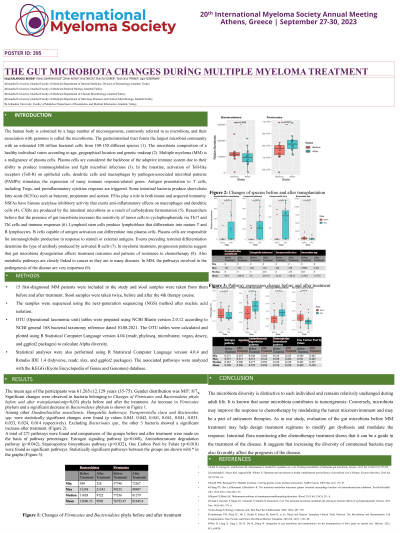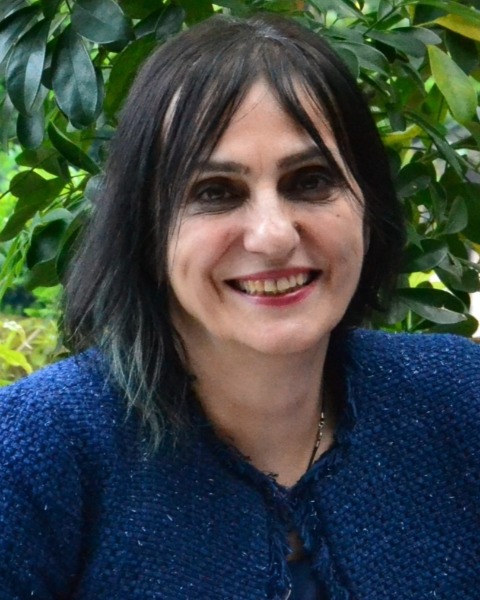Myeloma Microenvironment and immune profiling
Poster Session 3
P-395: THE GUT MICROBIOTA CHANGES DURİNG MULTIPLE MYELOMA TREATMENT
Friday, September 29, 2023
1:15 PM - 2:15 PM EEST


SEVGI KALAYOGLU-BESISIK
Professor
Istanbul University, Istanbul Faculty of Medicine/Department of Internal Medicine, Division of Hematology
Istanbul, Turkey
Introduction: It is clinically experienced and also biologically documented that multiple myeloma (MM) is in itself a heterogeneous disorder as covers multiple different characterized clones. Currently, the treatment is not strictly individualized yet and includes still high-dose chemotherapy with melphalan in transplant-eligible patients. We focused on emerging data on gut microbiota which may be disturbed during chemotherapy and may have a role in the passage of inflammatory mediators through the intestinal barrier. We studied microbiota changes in MM patients and documented the data at diagnosis and after treatment.
Methods: Stool samples were taken twice, before and after the 4th therapy course. The samples were sequenced using the next-generation sequencing (NGS) method after nucleic acid isolation. OTU (Operational taxonomic unit) tables were prepared using NCBI Blastn version 2.0.12 according to NCBI general 16S bacterial taxonomy reference dated 10.08.2021. The OTU tables were calculated and plotted using R Statistical Computer Language version 4.04 (readr, phyloseq, microbiome, vegan, descry, and ggplot2 packages) to calculate Alpha diversity.
Statistical analyses were also performed using R Statistical Computer Language version 4.0.4 and Rstudio IDE 1.4 (tidyverse, readr, xlsx, and ggplot2 packages). The associated pathways were analyzed with the KEGG (Kyoto Encyclopedia of Genes and Genomes) database.
Results: Fifteen newly diagnosed MM patients enrolled in the study. The mean age was 61.265±12.129 years (35-75). Gender distribution was M/F: 8/7. Microbiota profile before and after treatment showed a statistically significant change at the phylum level. After treatment, the Bacteroidetes phylum decreased while the Firmicutes phylum showed an increase. Duodenibacillus massiliensis, Hungatella hathewayi, and Paraprevotella clara proved to be also increased.after treatment.
The estrogen signaling pathway, aminobenzoate degradation pathway, staurosporine biosynthesis pathway, and One Carbon Pool by Folate was found as important pathways.
Conclusions: The microbiota diversity is distinctive to each individual and remains relatively unchanged during adult life. It is known that some microbiota contributes to tumorigenesis: Conversely, microbiota may improve the response to chemotherapy by modulating the tumor microenvironment and may be a part of anticancer therapies. As in our study, evaluation of the gut microbiota before MM treatment may help design treatment regimens to modify gut dysbiosis and modulate the response.
Methods: Stool samples were taken twice, before and after the 4th therapy course. The samples were sequenced using the next-generation sequencing (NGS) method after nucleic acid isolation. OTU (Operational taxonomic unit) tables were prepared using NCBI Blastn version 2.0.12 according to NCBI general 16S bacterial taxonomy reference dated 10.08.2021. The OTU tables were calculated and plotted using R Statistical Computer Language version 4.04 (readr, phyloseq, microbiome, vegan, descry, and ggplot2 packages) to calculate Alpha diversity.
Statistical analyses were also performed using R Statistical Computer Language version 4.0.4 and Rstudio IDE 1.4 (tidyverse, readr, xlsx, and ggplot2 packages). The associated pathways were analyzed with the KEGG (Kyoto Encyclopedia of Genes and Genomes) database.
Results: Fifteen newly diagnosed MM patients enrolled in the study. The mean age was 61.265±12.129 years (35-75). Gender distribution was M/F: 8/7. Microbiota profile before and after treatment showed a statistically significant change at the phylum level. After treatment, the Bacteroidetes phylum decreased while the Firmicutes phylum showed an increase. Duodenibacillus massiliensis, Hungatella hathewayi, and Paraprevotella clara proved to be also increased.after treatment.
The estrogen signaling pathway, aminobenzoate degradation pathway, staurosporine biosynthesis pathway, and One Carbon Pool by Folate was found as important pathways.
Conclusions: The microbiota diversity is distinctive to each individual and remains relatively unchanged during adult life. It is known that some microbiota contributes to tumorigenesis: Conversely, microbiota may improve the response to chemotherapy by modulating the tumor microenvironment and may be a part of anticancer therapies. As in our study, evaluation of the gut microbiota before MM treatment may help design treatment regimens to modify gut dysbiosis and modulate the response.
